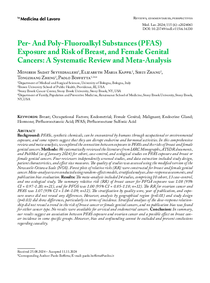Per- And Poly-Fluoroalkyl Substances (PFAS) Exposure and Risk of Breast, and Female Genital Cancers: A Systematic Review and Meta-Analysis

Seyyedsalehi, Monireh Sadat ; Kappil, Elizabeth Maria ; Zhang, Sirui ; et al.
2024
115
6
breast cancer ; occupational risks ; perfluorinated alkylate substances ; hormones
Occupational diseases
https://doi.org/10.23749/mdl.v115i6.16330
English
Bibliogr.
"Background:PFASs, synthetic chemicals, can be encountered by humans through occupational or environmental exposure, and some reports suggest that they can disrupt endocrine and hormonal activities. In this comprehensive review and meta-analysis, we explored the connection between exposure to PFASs and the risks of breast and female genital cancers. Methods: We systematically reviewed the literature from IARC Monographs, ATSDR documents, and PubMed (as of January 2024) for cohort, case-control, and ecological studies on PFAS exposure and breast or female genital cancers. Four reviewers independently screened studies, and data extraction included study design, patient characteristics, and effect size measures. The quality of studies was assessed using the modified version of the Newcastle-Ottawa Scale (NOS). Forest plots of relative risks (RR) were constructed for breast and female genital cancer. Meta-analyses were conducted using random-effects models, stratified analyses, dose-response assessments, and publication bias evaluation. Results: The meta-analysis included 24 studies, comprising 10 cohort, 13 case-control, and one ecological study. The summary relative risk (RR) of breast cancer for PFOA exposure was 1.08 (95% CI = 0.97-1.20; n=21), and for PFOS was 1.00 (95% CI = 0.85-1.18; n=12). The RR for ovarian cancer and PFAS was 1.07 (95% CI = 1.04-1.09; n=12). The stratification by quality score, year of publication, and expo-sure source did not reveal any differences. However, analysis by geographical region (p=0.01) and study design (p=0.03) did show differences, particularly in terms of incidence. Stratified analyses of the dose-response relation-ship did not reveal a trend in the risk of breast cancer or female genital cancers, and no publication bias was found for either cancer type. No results were available for cervical and endometrial cancers. Conclusion: In summary, our results suggest an association between PFAS exposure and ovarian cancer and a possible effect on breast can-cer incidence in some specific groups. However, bias and confounding cannot be excluded and prevent conclusions regarding causality."
This work is licensed under the terms of the Creative Commons Attribution 4.0 International License (http://creativecommons.org/licenses/by/4.0/).
Digital
The ETUI is co-funded by the European Union. Views and opinions expressed are however those of the author(s) only and do not necessarily reflect those of the European Union or the ETUI.